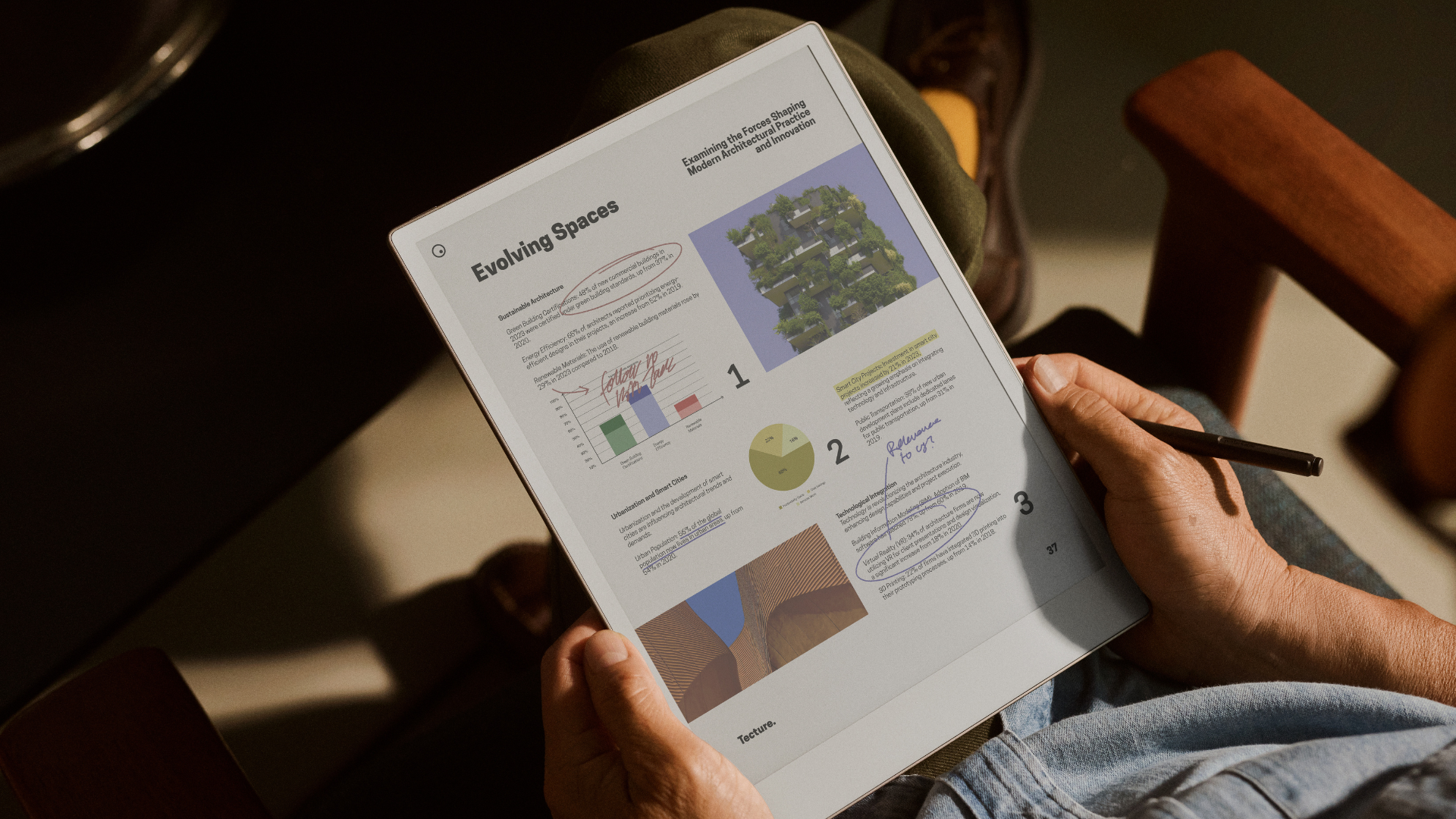
ALL RESOURCES / Case Studies
reMarkable keeps millions of devices updated and highly reliable with Memfault
3x Faster Releases
Release cycle shortened from 2–3 months to 3–4 weeks, accelerating time-to-market.
30–40% fewer hotfixes
Post-release fixes reduced by up to 40%, improving product stability.
5–10 engineers freed
Eliminated internal tooling saved 5–10 engineers’ worth of effort.

COMPANY PROFILE
reMarkable is a premium hardware company focused on enabling creative thinking through beautifully crafted paper-feel tablets. Their flagship Paper Pro combines proprietary display technology with a distraction-free user experience, delivering the tactile immediacy of pen and paper with the power of digital integration.
Founded seven years ago, the company believes that laptops are built for output, not for thinking. In contrast, their devices are designed for divergent thinking, activities like note-taking, active reading, doodling, and sketching, before ideas are ready to be structured into deliverables. This philosophy has resonated strongly with creatives, professionals, and knowledge workers seeking a distraction-free space to think clearly.
“We create the environment people crave when they want to think deeply. Our devices are about entering a flow, not managing technology.” — Nico Cormier, CTO, reMarkable
Their product vision spans B2C and B2B, with growing demand from enterprises and public sector institutions seeking tailored solutions that meet strong privacy, connectivity, and fleet control requirements.
Challenge
Rapid growth puts strain on in-house developed systems
Building on early momentum, reMarkable reached a stage where their systems had to evolve to match the ambition of their product. With rapid growth came new operational demands, especially around how software was built, shipped, and supported. The team had built their update and diagnostic workflows using both open-source tools and custom internal systems. Nico recalls, “At one point we had about 15 different homebrew systems all barely hanging together”. This setup supported reMarkable through early growth, but as the company scaled, its limitations became clear. It was fragmented and heavily reliant on tribal knowledge.
“The workflows were inefficient, and knowledge of a lot of these systems was very siloed. If a key person went on holiday, they might be the only one familiar with a system or step in our release workflow, and we could be blocked. This was just painful and unnecessary.” — Nico Cormier, CTO, reMarkable
The reMarkable team recognized early on that a reliable OTA system would be essential as their fleet scaled.
“OTA failures for hardware companies are existential. One bad update could mean you’re not just rolling back software, you’re recalling devices. That could bankrupt a hardware company. I could not sleep if we had a bad OTA system.” — Nico Cormier, CTO, reMarkable
The lack of integration and observability made it difficult to understand how devices were behaving in the field, detect regressions, or roll out software updates safely. They needed to understand the health of their battery life and connectivity reliability, all while feeling confident in their ability to improve them. As a premium brand, any customer friction, especially during the “warm-up period” of adoption, had outsized consequences.
“Our users invest significant time and money before they see the full benefit of our product. So, any quality issue early on can completely break the experience. We don’t get slack from our users.” — Nico Cormier, CTO, reMarkable
SOLUTION
Observability and OTA in one system, ready to scale
reMarkable selected Memfault to consolidate OTA update management and observability for their multi-million-device fleet into a single, integrated platform. Initially adopted during the development of their Paper Pro, Memfault enabled the team to validate and ship software with greater confidence.
“We phased Memfault into reMarkable Paper Pro, our latest product, and ran it alongside our old OTA system. The team helped us migrate smoothly, even supporting our unique setup until we could fully standardize.” — Nico Cormier, CTO, reMarkable
Memfault now powers several critical capabilities at reMarkable, including:
- Manage OTA updates with precise rollout control across distinct user groups: 650 internal testers, 75,000 beta users, and millions of production devices
- Monitor health and performance metrics like battery life, connectivity stability, and wakeups
- Analyze product usage patterns across different sleep and power states to optimize performance
- Debug pre-production issues efficiently using full crash data collected directly from the device
“Memfault makes it easy to segment the user base and push specific builds without the usual pain of managing firmware at scale.” — Nico Cormier, CTO, reMarkable
Memfault’s OTA helped the team bake quality gates into the release process, replacing inconsistent workflows and undocumented processes with a single, repeatable release process, making it easier for everyone.
“We don’t need a giant process anymore. Even when we bring on new engineers, they just need to learn the tool, and it enforces what we need with all the safeguards already built in. We gained a lot of control and improved business continuity.” — Nico Cormier, CTO, reMarkable
Memfault is foundational in how the engineering team develops, monitors, and releases software. Its observability capabilities allow reMarkable to monitor everything from battery life to connectivity performance, metrics that are crucial to maintaining the premium experience their product promises. The Paper Pro, in particular, has multiple power states, and Memfault helps the team understand battery performance in these different states.
“Battery, memory, CPU wakeups, Wi-Fi behavior, these things are hard to measure, but critical to quality. Memfault gives us that visibility in the field.” — Nico Cormier, CTO, reMarkable
These insights help detect regressions early and enable deeper collaboration across teams. The platform team uses Memfault to monitor system health and flag anomalies like unexpected battery drain or increased wakeups. When issues surface, they partner with the product team to correlate that with changes in user behavior captured through their product analytics tools.
“It usually starts with something we see in Memfault. Then we check the product analytics to see if it matches a change in behavior. That’s where the conversation starts.” — Nico Cormier, CTO, reMarkable
This workflow has created a tight feedback loop between platform and product teams, enabling faster diagnosis and smarter prioritization.
RESULTS
Faster releases, fewer bugs and more engineering resource focused on innovation
Implementing Memfault delivered immediate and measurable impact across engineering velocity, product quality, and team focus.
- Accelerated release velocity: Time-to-confidence for new releases dropped from 2–3 months to just 3–4 weeks
- Production hotfix reduction: Post-release patching for production devices decreased by 30–40%
- Increased operational efficiency: Freed up 5–10% of engineering time, equivalent to 5–10 engineers, by removing the need to build and maintain internal OTA and diagnostics system
“We’ve gone from release confidence taking two to three months to just three to four weeks. We also have a really low tolerance for bugs making it to production, requiring us to ship a fix and we have been able to reduce the number of production fixes required by 30–40%.” — Nico Cormier, CTO, reMarkable
Crucially, this freed up engineering resources to focus on product differentiation. At the same time they were onboarding Memfault, the team was launching an AI initiative to bridge the gap between creative ideation and productivity tools like documents and slides. Without Memfault, that innovation might have been delayed.
“If we hadn’t implemented Memfault, we might not have had the bandwidth to build our AI features. It freed up the equivalent of 5–10% engineering capacity, allowing the team to focus on delivering value and differentiation.” — Nico Cormier, CTO, reMarkable
Memfault is helping the entire company realize their vision for the product, continue to deliver exceptional quality and a great product experience. The impact Memfault has had is felt across the entire business.
“I don’t think the entire business knows about Memfault, but they definitely feel it.” — Nico Cormier, CTO, reMarkable
Memfault is also helping the company expand into B2B use cases with much more complex, custom requirements. As Nico remarks, “Some enterprise customers need Wi-Fi disabled, special builds, or visibility into their own fleet.” By supporting custom images and configurations within a unified OTA pipeline, they can meet enterprise IT requirements without fragmenting their engineering or release processes.
“We never thought we’d need to support multiple builds, but with Memfault, we can scale that without creating hell for our team.” — Nico Cormier, CTO, reMarkable

reMarkable partnered with Memfault to ensure product quality, accelerate development, and scale to a global, multi-segment customer base.
Memfault replaced a fragmented set of tools with a unified platform for OTA, observability, and analytics. This not only derisked software updates but also allowed the engineering team to focus on what matters: building exceptional products.
“Memfault is both our insurance policy and our velocity engine. It gives us full confidence to focus on the future instead of always looking in the rear view mirror, fearing the risks.” — Nico Cormier, CTO, reMarkable
With Memfault in place, reMarkable is shipping faster, improving product quality, and confidently delivering creative thinking tools to more users.
“We love working with mission-driven partners. Memfault isn’t just a tool, they care deeply about doing this well, they are the experts in what they do, just like we are, and that shows in the partnership.” — Nico Cormier, CTO, reMarkable